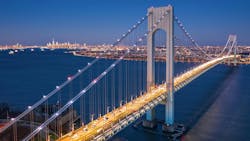Breathing New Life into Bridges
By Stuart Rankin, Contributing Author
America’s bridges are aging, with 42% being 50 years old or older, according to the Federal Highway Administration. The American Society of Civil Engineers estimates in its 2025 Report Card for America’s Infrastructure that nearly 231,000 bridges need repair and preservation work. At the current rate of investment, it could take until 2071 to address all necessary repairs—some of which, such as cable replacements, may cost hundreds of millions of dollars.
Rehabilitation is an alternative to replacing bridge cables. It can extend the lifespan and promote safety at a fraction of the cost of replacement.
Traditional maintenance methods—painting, caulking, oiling and monitoring cable conditions—are labor intensive, can disrupt traffic, stretch budgets, and may only be marginally effective.
But main cable dehumidification is a promising option.
Water is Trouble
For cables, corrosion is a primary driver for maintenance or repair. It occurs when water (or moisture) infiltrates them, reacting with oxygen and the steel wires themselves, causing rust.
Dehumidification systems address this concern by removing moisture from the internal cable environment––effectively acting like a giant “hairdryer” for bridges.
The process involves sealing the cable system, which sets the stage for controlling humidity levels and protects cables from pollutants. With the cables sealed, dry air is pumped through selected points along the bridge and moisture is extracted.
The dry air used for this process is generated in a specialized plant room, typically located on or beneath the bridge, where a large-scale dehumidifier extracts moisture and cycles dry air through the system. One project could require multiple plant rooms depending on the volume of air required.
The system’s design layout and specific components are tailored to each bridge based on factors including the space available for the plant rooms, the electrical capacity available for mechanical equipment, the existing fiber network and the owners’ preferences.
The amount of air that each cable receives is critical. Since cables receive different amounts of airflow, airflow tests at multiple locations help plan for long-term system performance, ensuring cables get airflow according to their needs.
Two factors that impact the system’s ability to dry the cables are the volumetric flow of air through the cables––the more air going through the cable, the more moisture can be purged––and the dryness of the air. Efficiency is measured by the relative humidity at the exhaust location. If the humidity is high, it’s a sign of system ineffectiveness. When the system is up and running, adjustments can be made in real-time.
Installation work can include oversight of mechanical, electrical and controls engineering. It also provides an opportunity for cable inspection and strength evaluation, as well as the sealing of cables, where every seam receives focused attention. Sensors also are installed to enable ongoing data monitoring of relative humidity, air pressure and flow at the exhaust points of each cable.
The result is a bridge with cables that are protected from corrosion, significantly extending the lifespan of its suspension cables and the bridge itself.
Dehumidification in Action
While bridge dehumidification has been used for years in parts of Asia and Europe, the first dehumidification project in the U.S. was completed in 2015, extending the life of Virginia’s 64-year-old Chesapeake Bay Bridge.
Shortly thereafter, the Delaware Memorial Bridge also adopted a dehumidification system. Built in 1951, the 10,800-foot-long dual suspension bridge connects New Jersey and Delaware, accommodating approximately 100,000 vehicles daily.
Completed in 2019, the award-winning dehumidification project took a design-build approach and was completed in 23 months—one year ahead of schedule. By avoiding the costly replacement of the bridge’s 8,000 strands of steel, the project saved millions of dollars.
Since then, main cable dehumidification systems have been installed on Pittsburgh’s South Tenth Street Bridge, plus Ohio’s Anthony Wayne Bridge.
Similar dehumidification systems are being installed on New York’s George Washington Bridge and RFK Bridge. The main cable dehumidification systems for the Verrazano-Narrows Bridge and the Walt Whitman Bridge in Philadelphia also are nearing construction.
Life-cycle cost analysis can help quantify the long-term value of dehumidifying cables, anchorages or both, helping to make the case for incorporating dehumidification into each state’s transportation asset management plans.
To maximize resources, dehumidification should be considered as part of a holistic approach to suspension bridge maintenance, evaluating everything from modern technologies to the training and support required to implement an effective asset management plan.
Moving beyond traditional maintenance approaches and adopting forward-looking asset management methods can position owners to cross the bridge before they come to it. RB
Stuart Rankin is a senior vice president, national bridges and structures practice, for WSP.
